Realm of the Elderlings: Series by series reviews and reading experience
How was it to read The Realm of the Elderlings? After my spoiler-free overview in the previous post, this post will contain more in-depth reviews which were largely written as StoryGraph reviews as I was reading each book, and then later assembled here into a coherent post.
Some books or sub-series were definitely a lot easier to read than others. Each was a somewhat different experience, but to summarize it: once I really got started with this series, I was hooked and it was easy to go through these tomes that average roughly 683 pages.
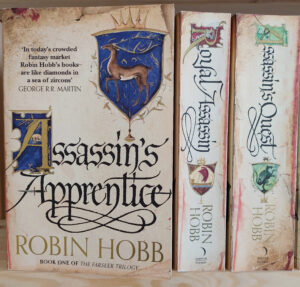
The Farseer Trilogy
I picked up the first book of this trilogy, Assassin’s Apprentice, from my pile of unread books on 11 November 2024. It had been waiting there for me for a year, and I felt it was finally time. My expectations were high.
Initially, it took me a while to get into this book. I think this was mainly because I struggled a bit to find the time and mind space to read. However, once I was about halfway though, I suddenly read the bulk of it within 2 days.
The protagonist of these books is Fitz, who is only a child at the beginning of this book, but a teenager at the end of it. He is the bastard child of the heir to the throne King-in-Waiting Chivalry Farseer, who due to Fitz’ existence had to abdicate his throne. However, Fitz grows up at court, first living in the stables as a stable boy, and later becoming an apprentice to the assassin of the Farseer court. Fitz also happens to have the ability to telepathically communicate with animals, which is a feared and stigmatized magic in this medieval world.
My initial impression was that it’s a great, immersive world with subtle, strange magic and lots of intriguing characters. I did have a lot more questions once I finished the first book, which I hoped will be answered in the second and third book.
The second book, Royal Assassin, made me really fall in love with this world. It’s so well written and fleshed out and never boring. So realistic that it really makes me appreciate living in a world of heated blankets. What a gripping, infuriating story, I couldn’t wait to learn how it ends in book three.
The third book, Assassin’s Quest, really lived up to its name, because it’s probably one of the most epic quests I’ve experienced. 860 pages of hardship that this poor protagonist had to go through, but it’s so well-written that it never gets boring. The world building is excellent and feels so real and alive, with some low- to medium-fantasy elements. I especially loved that animals play such a big role in these books, it’s not something that I commonly see done well in novels.
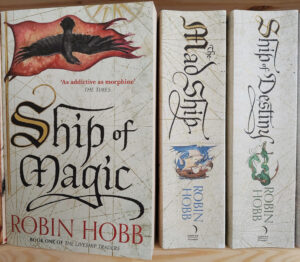
The Liveship Traders
After devouring The Farseer Trilogy, which is chronologically the predecessor to this trilogy, I struggled a bit with my expectations of The Liveship Traders once I started reading the first book Ship of Magic. It is a vastly different reading experience, despite this being set in the same universe as the Farseers.
What I struggled with most is the vast number of different Point-Of-View characters (unlike in Farseer, where we only see the world from Fitz’ perspective). In this book, there are about 10 or so POV characters of varying degrees of interestingness. I found some of them extremely tedious to read and often found myself speed-reading over those, especially if they dragged on. That is another issue I had with this book; there are a lot of scenes and conversations that go on and on and on with very, very little actual valuable content, sometimes even circling around themselves.
Aside from these issues, the premise of this book is certainly fascinating. It takes place in the Cursed Shores, which are dominated by traders owning magical “liveships”, ships that have moving, talking figureheads, that can communicate telepathically, and that have a very strong bond to the family that owns them.
We see this mostly from the point of view of characters of the Vestrit trader family and their liveship Vivacia. But there are other characters, whose connection only becomes clear at the end of the entire series.
There were characters that I really enjoyed reading about, in particular Althea, Winthrow and Vivacia. Others, such as Ronica, were a bit tedious, and some I outright hated reading, such as Kennit. I felt that if the whole book was just Althea’s or Vivacia’s POV, and if it was condensed to 400-500 pages (instead of 880), it would have been absolutely brilliant. But of course there’s a purpose to all of this, which only comes together in the later books.
Already in the second book, The Mad Ship, finally a lot of threads came together, but I still share some of the complaints that I had about the first book: It’s too damn long. Too many drawn-out conversations especially. If this was streamlined into a book of 200-400 pages less, it would have been a riveting page turner. The conclusion though, was yet again mostly a setup for book three.
Finally, the third book, Ship of Destiny, gave us the convergence of all these plotlines, and there were sure a god damn many of them. ALL the plotlines and characters that were painstakingly established in the previous two, 900-page tomes come together to an epic finale. I stand by my verdict that all of these books are too lengthy and verbose, and focus too much on drawn-out conversations. But was it worth reading them? YES.
A lot of things happened in this final book that left me in emotional turmoil. First and foremost, there are all the revelations relating to Kennit, a character that I hated with a passion from the first book. He’s a narcissistic, manipulative psychopath. This book shows us why exactly he is how he is, sometimes even trying to make us sympathize with him and his tragic backstory. But by the time he rapes one of the main characters, there’s really no doubt left about him. The rape is shocking in more than one way, because I felt it comes with a lot of gaslighting and victim blaming. I just wanted to scream at all these characters to please just believe and listen to survivors! Lots of tough topics to chew through here.
One of the most interesting hints this book revealed relate to the character of Amber. The book heavily implies that she is the Fool from the Farseer books. While I’m trying to wrap my mind around that, I now seriously would like to re-read all 2700ish pages of these three books to see where that was coming from, and if there are more hints earlier on. Needless to say I’m excited to start reading The Tawny Man trilogy next.
Altogether, while I struggled a bit throughout the first 1-2 books of The Liveship Traders, I’m beginning to see why people say this is even better than the Farseer books. I don’t think it’s necessarily better. I really loved the Farseer books for their medieval vibes and the animals bonds. They are just two very different series. The Liveship Traders is overwhelming with it’s vast amount of POV characters at first, but ultimately they all have their important place in the larger plot, and the character development is insane. A slow but great series, and I have a feeling we haven’t seen the last of these characters.
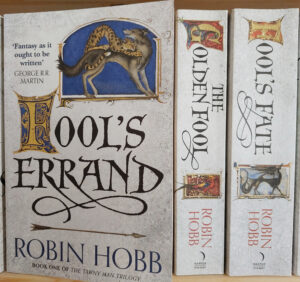
The Tawny Man
All throughout reading the Liveship Traders, I’ve been so looking forward to the moment I can start reading Fool’s Errand. Finally, Fitz is back! This book is set ~15 years after the Farseer Trilogy (and incorporates some minor details from the Liveship Traders as well). Fitz has been living in isolation under a different name, but soon his old life comes chasing him into a new adventure.
Reading this book was both wholesome and heartbreaking. It’s soo good to see all the characters coming back together, it feels like coming home after a long, long time away. The Fool is back under yet another guise. Reluctantly, Fitz yet again does his duty, and goes through quite a bit of character development.
The heartbreaking part of this book is of course Nighteyes and his steadily declining health. Having had dogs and watching them grow old, I can really feel how hard it is to go through that. Sadly, it’s a big part of caring for an animal that all who are bonded to them must go through.
This book, similarly to the Farseer books, handles animals so well. Having grown up with animals, I love reading how all these animals in this book are not only animals, but characters, no matter if wolf, dog, cat or horse. I don’t think I’ve ever seen it done so well in fiction.
My only complaint with this book is that Fitz should really have just told Dutiful what was going on earlier. I understand it’s difficult because of the cat/woman, but it was a bit infuriating. My second complaint was that the ending felt a bit like a Deus Ex Machina, with people arriving in the right place at precisely the right time. Regardless, this book was such a pleasure to read (despite it’s heartbreaking aspects) that I devoured it within a week.
On to the second book of this series, The Golden Fool, and the dualities of this book are manifold. It was fun to read, and I read it in record time. But what really actually happened in the plot? Why is the book called “The Golden Fool”, when the Fool is barely the focus of 90% of the book?
As I said, I really enjoyed reading it. It’s just so well written and the characters are fun, as it’s slowly uncovering the mysteries of this universe. But I’m definitely disappointed by the lack of actual story progress regarding the titular character of both the book and the trilogy here. That is made even worse by Fitz and the Fool having this silly fight, and then behaving like stupid teenagers half of the book. Instead of sitting down and having a serious, adult conversation, they are stonewalling each other, and are being cold, petty and just infuriatingly silly. It was fairly obvious to me that this was just a plot device to stall the plot and drag it out for what I assume will be the conclusion in book three of this trilogy. I hate it. That’s one of the reasons why this book is not a solid 5/5 for me.
Another reason for me is the lack of animals. All of the books with Fitz really shined with his bond beasts, and I felt that these characters were really missing here. I understand why it’s missing here, but it still altogether makes it feel like this book is not whole. Very much a second book experience focusing more on world-building than plot advancement.
This story finally comes full circle in the third book, Fool’s Fate. What began in the first trilogy (The Farseer Trilogy) was resolved in this trilogy (The Tawny Man) with a little help from aspects of the second, somewhat unrelated trilogy (The Liveship Traders).
To summarize, in this ninth book of the series, which is the sixth book with Fitz as the protagonist, a lot of unanswered questions are finally answered, such as everything to do with the Red Ship War from the first trilogy. We finally learn what was actually behind that and it comes to a great ending.
Also, the story of Fitz comes to a somewhat satisfying conclusion, after much, much heartbreak, of course (it wouldn’t be a Robin Hobb book otherwise). The story dives deep into the relationship of Fitz and the Fool as we learn of the gruesome fate that he suffered. A lot of things happen, but in the end Fitz finally becomes whole again – quite literally. He realizes that having given away his pain and suffering to Girl-on-Dragon made him less of a person. It is actually very similar to what Kennit and Paragon did in the Liveship Traders, but with a much happier conclusion for Fitz.
Personally, I still really miss the animal aspects though. No wit-bond means much less animals, and that was always one of my favorite aspects of all the books with Fitz. There are, of course, 7 more books in this series, and 3 more with Fitz. With such a great ending, I really wonder where the story will take him. But first, dragons…
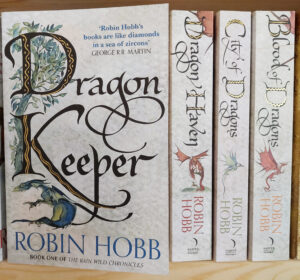
The Rain Wild Chronicles
After my experience reading Liveship Traders being a tad tedious and the immense joy of reuniting with Fitz in The Tawny Man, starting to read Dragon Keeper was a bit harsh. It definitely lessened my enjoyment of this book, because honestly I just wanted to get through The Rain Wild Chronicles so I can start reading Fitz and the Fool.
What I also found very vexing was that once again, this book was full of new characters. Why? I was annoyed at this because why couldn’t this story have been told with all the characters we know already from The Liveship Traders? I kinda expected Selden to be the main character, but alas, he was not. I guess there are plenty of reasons, but my patience for new characters was at zero, especially since, as mentioned before, I just want to go back to Fitz and the Fool. Well, some characters from Liveship Traders make appearances, which is great, but they’re only side characters that appear rather briefly.
But what about this book when looking at it outside of its context (if that is even possible)? I thought it was alright, but I have to admit I became more interested in reading once I saw a few spoilers, namely that there are LGBTQI+ characters here, and that the 3 main characters that all start out with their individual plot lines, eventually converge (and bond).
The main characters are Leftrin, Thymara and Alise. I hated Leftrin at first, but he became more interesting once he met Alise. Alise seems incredibly naive, reading her part was a bit infuriating because she couldn’t see what was really going on with that utter asshole Hest (and Sedric). Thymara was interesting as well, but I was still waiting for interesting plot development on her.
The most interesting thing about this book is perhaps all the lore that we learn about dragons. This is, after all, something that the entire series has been working towards. It’s a bit pitiful though to see that all the efforts of Ship of Destiny turned out as they turned out here.
The book ends rather abruptly and was obviously just setting things up for the rest of the series.
I’m not sure if Dragon Haven was a great improvement over the first book in the series, or if the characters simply grew on me. To be honest, this book was again a tad too slow-paced for me. It only became interesting in the final quarter or so. Most of the book is literally a slow, muddy slog of dragons and keepers working out their problems, differences, hormones, etc. I honestly think that this plus Dragon Keeper could easily have been shortened into one book of max 500 pages.
What’s to like though, is the strong character development, which Robin Hobb time and again excels at. It’s honestly insane how much her characters develop. I also enjoyed that this book was a lot queerer than any of the other books in her series so far, making this whole universe a tiny bit less old-school.
In book three, City of Dragons, you’d think they finally made it! Or not… Sometimes I feel like Hobb uses plot devices to artificially prolong her plots, and it’s the same with this book. The 2-book-long journey to Kelsingra finally ended, but they still haven’t really ‘arrived’ there yet, have they?
What I did like about this book though, was that finally some of the characters from The Liveship Traders are starting to play a bigger role – which I kinda expected from the first two books in Rain Wild Chronicles, from which they were rather absent.
This book is thankfully a lot shorter than most of this series, and thus moving at a more bearable pace. It still very much is setting up the finale. And I already dread what’s gonna happen there, because everything points towards utter devastation by capitalism, too much like the real world. But I guess the dragons will have a few words to say on that.
In the final book, Blood of Dragons, finally, finally, dragons have returned to the world after a long, long journey. This book finally ties together the other three books in this series, which tended to be a tad tedious. The city is being rebuilt, the dragons are becoming worthy of their name, and Elderlings are returning to the world.
This book also touches on a lot of topics from the Six Duchies parts of the series, and we learn a lot of lore on how the magic of this world works and where it’s coming from. But it is seen from a different perspective, leaving a lot of mysteries yet to be solved. I’ve been wondering if and how all of this will eventually be tied together in the final trilogy.
Altogether, a really good conclusion to the Rain Wild Chronicles. I wish the first three books would have been more concise, whereas I think this book could possibly have been a bit more detailed. I find it a bit ironic that some books seem to ramble on endlessly, and in this final one, sometimes some events are just skipped and we fast forward in time.
But the strong suite of all the Elderlings books has always been its characters and their development, and the same goes for the Rain Wild Chronicles. These characters are unrecognizable by the end of the series, that’s how much they changed – and that includes the dragons, who were clumsy, pitiful beings at the beginning of this series. By the end of it, they are warriors as much as the rag-tag band of keepers have become.
Extra points for this being the queerest of all Elderlings books so far, with no less than 6 gay characters, and some hints of polyamory!
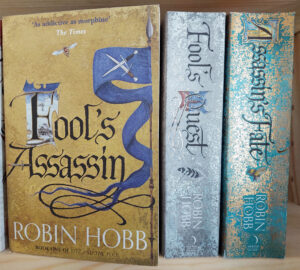
Fitz and the Fool
This is it, the first book of the final series, Fool’s Assassin. The beginning of the end. And we’re back to Fitz, in what I expected to be tieing up ALL the vast threads in this massive universe…? Or not?
This book is absolutely not what I expected, starting with the misleading title – I kept reading and reading and reading, waiting for the Fool to show up. What I got instead, is a very odd child for the majority of the book, Fitz’ daughter Bee. While it was interesting to see her perspective as well, it was also VERY jarring at first. I love Fitz’s books so much because he is the narrator, and it’s just fascinating to get lost in him. I don’t dislike Bee’s narrations, but it somehow doesn’t feel quite natural to me after so many books I already spent with Fitz.
As for the plot, well it feels like this is just a very slow start to it. The first couple of chapters were a bit erratic with multiple time jumps and fast forwards until we reached “the present”. As for the plot, well it seems obvious to me that Bee is a product of Fitz’s union with the Fool (and Nighteyes), and that she’s the unexpected son because she likes to dress like a boy. But where will this story ultimately lead? With this cliffhanger, who knows…
The second book, Fool’s Quest, picks up exactly where the first one left off. And it’s a bit funny, this book actually has very little plot, but it still manages to fill 740 pages that are devoured with ease. Bee has been kidnapped, and Fitz and the Fool are reunited at last – but both are forever changed by their pasts. A large part of this book is preparation for what’s to come, with Fitz being infuriatingly stubborn while the Fool once again found a way to outsmart him.
Towards the end of this volume, it seems like everything finally comes together. And I truly mean everything – all 14 books that came before this one. This is of course when Fitz arrives in Kelsingra, together not with the Fool, but with Amber. And we see Fitz with the Skill and the Wit alongside the Dragons and the Elderlings with the Silver. But of course, it ends on a cliffhanger, so I expect that the final volume will neatly tie all of those vast silvery threads together, worthy of such a monumental series.
Assassin’s Fate again picks up exactly where the previous book left off and works toward an epic, emotional conclusion as Fitz and his entourage race towards Clerres to find Bee. But Bee, busy as she is, seems to be way ahead of him and takes matters into her own hands shortly before he gets there.
All of this ultimately leads to the end of Fitz, which, honestly, has been a long time coming throughout all three of these books. I knew the moment that Chade led him to the stage in Fool’s Assassin that his fate his sealed, we’re approaching the end of his story.
It was infuriating that they left him in the tunnel, and I couldn’t believe that that would be how his story ended. I was happy it was not, and I hoped so much for a happy end for him. What he got was so bittersweet. Immortalized, a wolf forever in union with his beloved. And checking back on the end of the third book Assassin’s Quest, it wasn’t even a surprise. The book ends with the sentence “We dream of carving our dragon.”
This book was an absolutely worthy conclusion to an epic series, and it ties together so many threads from all of the other 15 books. However, there are still some unresolved questions that have been bugging me through this series, the answers to which were never made quite clear. Why did Fitz never seek out his mother, and how did he not remember her in the first place?1 What really happened when Fitz was stuck in the Skill pillar at the end of this book? And what is the Skill really? A different dimension? The afterlife? I feel we missed a great opportunity here to go deeper into this river. And how do all these different but similar magics relate to each other, the Skill, the Wit, the Dragon Bonds, the scrying? And I would have loved to learn more about the Fool’s origins and family, which was always very vague. Almost as vague as the whole story around the White Prophets and the Dragons. I felt the potential of that story line was bigger than the little hints of their history that we got.
This series is a masterpiece like no other I’ve ever read. I can’t believe it’s over. Half a year2 after I started Assassin’s Apprentice, I finally learned his Fate. I don’t know what to do with my life now.
And with this, I’ve summarized my personal reading experience with all of these books. In my next post, I’ll take a deep dive into the themes and characters of the books.


Thus was fantastic! Such a treat to reminisce on the epic journey that was Elderlings. I think you’ve done a great job at highlighting both strengths and weaknesses.
I never saw the similarity, between Fitz and Girl on Dragon, and the relationship between Kennit and Paragon. Excellent insight!